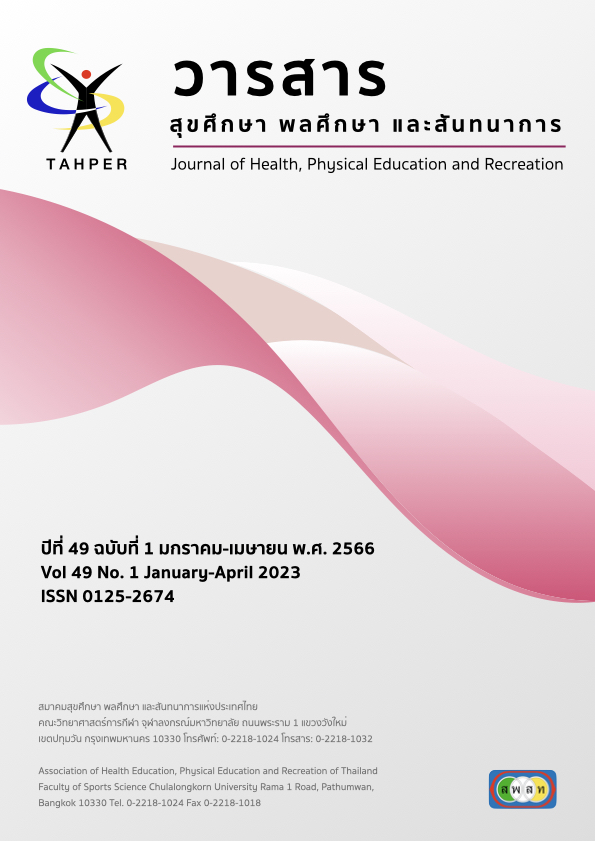Effectiveness of Sexual Behaviors Prevention Program among Female Primary Students at Piboonprachasan School
Main Article Content
Abstract
This study was a quasi-experimental research and the objectives was to study the effectiveness of Prevention program of sexual risk behaviors in female students at the upper secondary level at Piboonprachasan school. The research was conducted by studying before and after experiment. Sample of 60 female students were divided into 2 groups; experimental and control group. Each group has 30 female students. The experimental instrument was prevention program and questionnaire developed by a researcher for data collection. Data were collected for 2 times-before and after the experiment. Data were analyzed by using analytical statistics, percentage, mean, standard deviation, dependent-samples t-test and independent-samples t-test.
The study results had shown as follows:
- experimental group in after experiment had better mean of knowledge of sex, attitudes towards sex, awareness of risk opportunity for sexual risk behavior, perception of severity of sexual risk behavior and benefit in self-practice to prevent sexual risk behavior, self-confidence and preventive behavior against sexual risk behaviors than before experiment at the statistically significant at level of 0.05.
- experimental group in after experiment had better mean of knowledge of sex, attitudes towards sex, awareness of risk opportunity for sexual risk behavior, perception of severity of sexual risk behavior and benefit in self-practice to prevent sexual risk behavior, self-confidence and preventive behavior against sexual risk behaviors than control group at the statistically significant at level of 0.05.
Article Details

This work is licensed under a Creative Commons Attribution-NonCommercial-NoDerivatives 4.0 International License.
Critical thinking in journals is the right of the author. The Association of Health Education, Physical Education and Recreation of Thailand is not always required, to create diversity in ideas and creativity.
ความคิด ข้อวิพากษ์ในวารสารเป้นสิทธิของผู้เขียน สมาคมสุขศึกษา พลศึกษา และสันทนาการแห่งประเทศไทยไม่จำเป็นต้องเห็นชอบด้วยเสมอไป เพื่อให้เกิดความหลากหลายในความคิดและความสร้างสรรค์
References
ฐิตารีย์ เธียรสุทัศน์. (2557). ประสิทธิผลของการสร้างเสริมทักษะชีวิตทางเพศศึกษาต่อการเปลี่ยนแปลงพฤติกรรมการป้องกันความเสี่ยงทางเพศของนักเรียนชั้นมัธยมศึกษาตอนต้นโรงเรียนบางหลวงวิทยาจังหวัดนครปฐม. กรุงเทพฯ: สาขาวิชาสุขศึกษา, มหาวิทยาลัยเกษตรศาสตร์.
นิพนธ์ ดาราวุฒิมาประกรณ์. (2558). วัยรุ่นใช้สื่อออนไลน์อย่างไรในการหาคู่. สืบค้น 17 พฤศจิกายน 2561, จาก http://www.ms.ipsr.mahidol.ac.th
พรพิมล เจี่ยมนาครินทร์. (2539). พัฒนาการวัยรุ่น. กรุงเทพฯ: ต้นอ้อแกรมมี่.
พูนสุข ช่วยทอง. (2541). พฤติกรรมทางเพศของเยาวชน: วิสัยทัศของครู-อาจารย์ วิทยาลัยเทคนิค. วารสารพยาบาลสาธารณสุข, 12(3), 81-87.
เยาวลักษณ์ แสนทวีสุข, พรรณี บัญชรหัตกิจ. (2554). ผลของโปรแกรมสุขศึกษาโดยประยุกต์ทฤษฎีความสามารถตนเองร่วมกับการสร้างแรงจูงใจเพื่อสร้างเสริมพฤติกรรมทางเพศที่พึงประสงค์ของนักเรียนชั้นประถมศึกษาปีที่ 6 โรงเรียนแห่งหนึ่ง จังหวัดอุบลราชธานี (วิทยานิพนธ์ปริญญาสาธารณสุขศาสตร์มหาบัณฑิต). ขอนแก่น: สาขาวิชาสุขศึกษาและการส่งเสริมสุขภาพ, มหาวิทยาลัยขอนแก่น.
วิลาวรรณ มากยอด. (2557). ผลของโปรแกรมส่งเสริมการรับรู้สมรรถนะแห่งตนต่อความเชื่อมั่นในการป้องกันพฤติกรรมเสี่ยงทางเพศและการมีเพศสัมพันธ์ที่ปลอดภัยของนักเรียนวัยรุ่นหญิงในการศึกษานอกโรงเรียน (วิทยานิพนธ์ปริญญาพยาบาลศาสตร์มหาบัณฑิต). กรุงเทพฯ: สาขาวิชาการพยาบาลเด็ก, จุฬาลงกรณ์มหาวิทยาลัย.
สำนักโรคเอดส์วัณโรค และโรคติดต่อทางเพศสัมพันธ์ กรมควบคุมโรค กระทรวงสาธารณสุข. (2559). รายงานผลการดำเนินงานสำนักโรคเอดส์ วัณโรคและโรคติดต่อทางเพศสัมพันธ์. กรุงเทพฯ: เจ. เอส. การพิมพ์.
สำนักอนามัยการเจริญพันธุ์ กรมอนามัย กระทรวงสาธารณสุข. (2558). สถิติการคลอดของแม่วัยรุ่นประเทศไทย ปี พ.ศ. 2558. นนทบุรี: ชุมนุมสหกรณ์การเกษตรแห่งประเทศไทย จำกัด.
World Health Organization Western Pacific Region. [WHO]. (2004X. Adolescent health
and development: A WHO regional framework 2000-2004. from WHO Western Pacific Region Office Website: http// www.who.int


